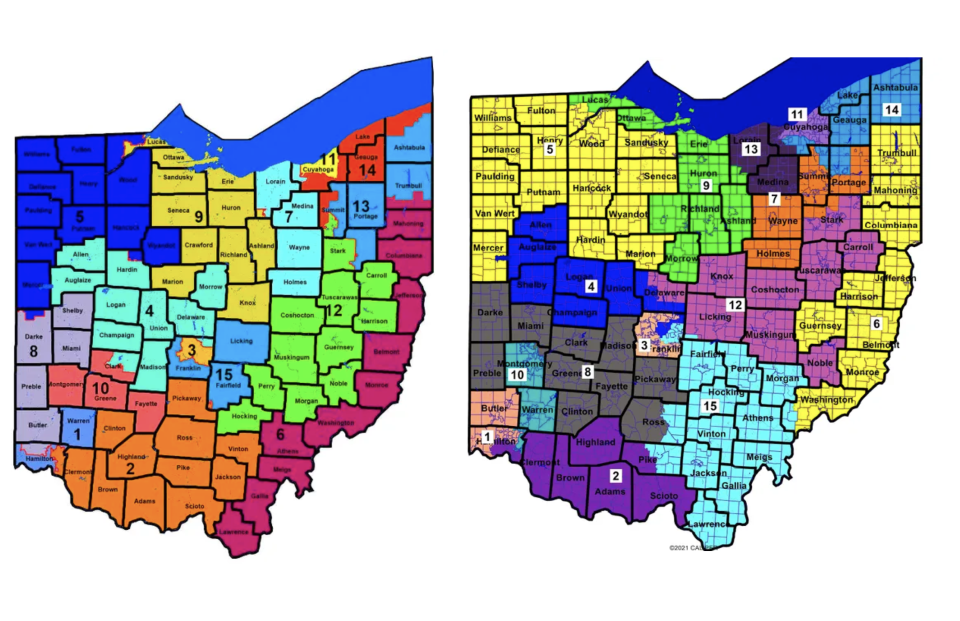Frustrated Ohioans, furious Jim Jordan: Ohio's congressional maps have a long way to go
- Oops!Something went wrong.Please try again later.
- Oops!Something went wrong.Please try again later.
Ohio voters waited years to see if changes aimed at creating more fair maps would work.
The stakes are high: Lines drawn this month could determine how many Republicans and Democrats represent Ohio in Washington D.C. in the years to come. Ohioans said they wanted maps where their preferred candidate had a shot and their pick represented their community.
But Ohio Democrats panned Republicans' initial offers, which could give the GOP as much as a 13-2 advantage in a state that former President Donald Trump won, 53% to 45%, in 2020. And Republicans say Democratic proposals aren't competitive enough.
Here's a look at where negotiations stand, fewer than three weeks before the map final deadline.

How competitive should maps be?
Voters want competitive districts where neither Democrats nor Republicans have a cake walk in the general election, says Senate President Matt Huffman, R-Lima.
"The fundamental problem with the Democrat House map is of 15 districts, 12 of them are not competitive," Huffman told reporters Wednesday. "That's not what the reform was about. The reform was about competitive districts, compact districts, communities of interest and a number of other things that were in the constitution."
According to the popular redistricting analysis tool, Dave's Redistricting App, the House Democrats' proposed map creates eight districts where one party is favored by 60% of the vote or more – more than any map proposed by lawmakers but fewer than the 12 Huffman cited.
Competitiveness isn't a requirement under the voter-approved changes to the Ohio Constitution. But if Republicans pass a four-year map without sufficient Democratic support, they must explain why their map does not unduly favor one party over another or unduly split counties and municipalities.
Senate Republicans' map gets the highest marks for competitiveness of the four proposals on the popular redistricting analysis tool, Dave's Redistricting App. Nearly 39% of Senate GOP districts are deemed competitive compared with 25% to 26% on the two House maps.
More: Ohio Republicans propose congressional district maps advantaging the GOP. See them here
One district made more competitive under the Senate GOP proposal is Republican Rep. Jim Jordan's 4th congressional district. It's hard to say who is more upset about that proposal: Jordan or his would-be constituents in Franklin County.
"Jim Jordan allies furious at proposed redistricting map," read one Fox News headline. Meanwhile, Ohioans testifying about the map pleaded with lawmakers not to combine Columbus' progressive Clintonville and predominantly Black Linden with rural Champaign County.
See the House Republican map, House Democratic map, Senate Republican map and Senate Democratic map on Dave's Redistricting App.

The urban divide
Democrats' maps score much higher on proportionality – whether the maps match the statewide voting preferences of Ohioans. Those preferences have averaged 54% for Republican candidates and 46% for Democratic candidates over the past decade. So a proportional map would favor Republicans 8-7.
The Ohio Constitution has no requirement that the congressional map matches the statewide preferences of voters, but it's one measure used to measure "fair maps." Both GOP maps could create a 13-2 advantage for Republicans.
The Senate Democratic map would favor Republicans, 8-7, while the House Democratic map would favor Republicans, 9-6. Democrats hit these numbers by not slicing and dicing cities and urban counties, as both GOP maps do.
For example, if mapmakers keep Cincinnati in a district wholly contained in Hamilton County, it creates a Democratic district. Combine it with several surrounding rural counties and the district can swing toward Republicans.
More: E.T.'s finger, LeBron James, and 'confusion:' Why Ohio's new congressional maps are causing headaches
Both GOP maps split Franklin, Hamilton and Cuyahoga counties twice; the House GOP map also splits Summit County twice. Democratic proposals do not split any county more than once.
Huffman, for his part, says the House GOP plan splits the state's major cities too much.
"The major cities should not be separated between different districts," Huffman said. "I would prefer not to split these major cities like Toledo."
How the sausage gets made
Ohioans trying to weigh in on maps have faced unnecessary hurdles and frequent confusion, several residents testified on Wednesday.
More: No meetings, no map mean Ohio Redistricting Commission could punt mapmaking to lawmakers
Julia Cattaneo, of Columbus, said she struggled to find out when and where a joint committee reviewing the maps was meeting.
"With something this important, there should be a better way," Cattaneo said.
Details on the three committees reviewing congressional maps – House Government Oversight, Senate Local Government and Elections and the Joint Committee on Congressional Redistricting – are often listed on the Ohio Legislature's website, but they are obscured under multiple tabs. There is no dedicated landing page for redistricting information.
The joint committee did not publicize which bills or topics it would review until four-and-a-half hours before the committee began. Those testifying were limited to five minutes to weigh in on all four maps.
Still, Sen. Theresa Gavarone, R-Bowling Green, says lawmakers welcome public input to improve the final map.
"You get the best result when you listen to the people you serve," said Gavarone, who leads a committee reviewing maps.
'It is very fluid'
Ohio lawmakers have proposed four different maps in four different bills. By the end of Nov. 30, they must pass one map in one bill. How they'll get from point A to point B is anyone's guess.
"This is the first time we're going through this process. It is very fluid," said Rep. Shane Wilkin, R-Hillsboro, who leads a committee reviewing maps. "I think I'd be surprised if we've seen The Map."
More: Ohio is using a new process to draw state, congressional districts. Here's how it works
That means lawmakers will revise the proposed maps, hoping to reach a compromise that will satisfy 60% of legislators in each chamber and 33% of Democrats – the threshold needed to enact a map that lasts 10 years. Democrats say they can't support the GOP maps as introduced.
The joint committee – a requirement under voter-approved changes to the state constitution – meets at 10:30 a.m. Friday but is not expected to issue any recommendations or pass a map.
"I don't know what the next steps will be at this point," Gavarone said. "They're still being worked out with the House and the Senate."
Jessie Balmert is a reporter for the USA TODAY Network Ohio Bureau, which serves the Akron Beacon Journal, Cincinnati Enquirer, Columbus Dispatch and 18 other affiliated news organizations across Ohio.
This article originally appeared on The Columbus Dispatch: Split cities, upset Jim Jordan: where Ohio's congressional maps stand

